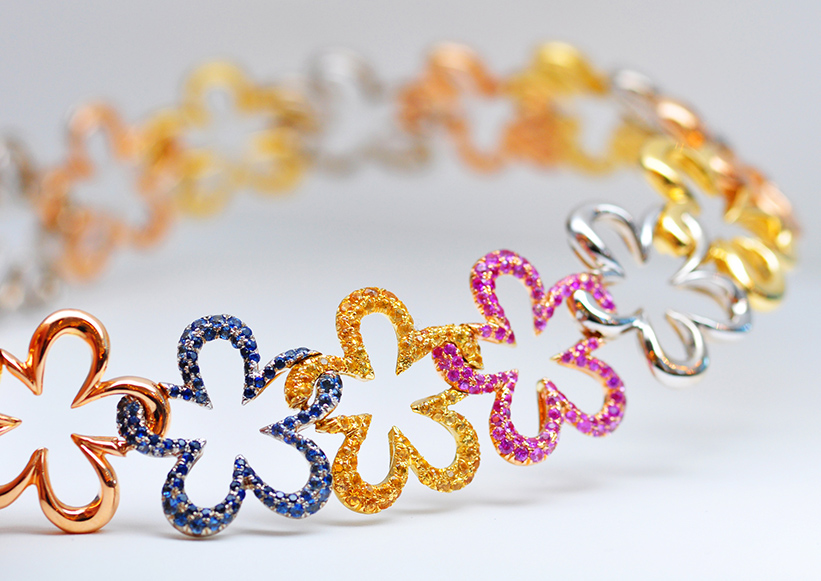 Janet Deleuse Image
Janet Deleuse Image
Janet Deleuse Jewelry, Shop the collection: deleuse.com
Mucha motif hand-carved blue agate cameo, large grey South Sea Baroque Pearls, 18k
On a European trip I happened to be in Prague during the opening of the Mucha Museum in 2002; so inspired, I created this cameo & pearl necklace. His work was genius, the art is fluid and has the movement of freedom depicting reality mixed with fantasy. Art Noveau was Mucha’s spiritual essence– as it flowed from his veins like no other. Janet
Alfons Maria Mucha 24 July 1860 – 14 July 1939. Mucha produced a flurry of paintings, posters, advertisements, and book illustrations as well as designs for jewelry, carpets, wallpaper and theater sets in what was termed initially “The Mucha Style” that later became known as Art Nouveau.
 image credit: Getty Image
image credit: Getty Image
Exhibition in Cedar Rapids explores Art Nouveau and the Czech artist who inspired others
CEDAR RAPIDS, IA.- Paintings, jewelry, sculptures and lithographs comprise the opening exhibition Alphonse Mucha: Inspirations of Art Nouveau on view now at the National Czech & Slovak Museum & Library. More than 230 pieces from the Mucha Foundation in Prague and in London are included in the exhibit.
Art Nouveau influenced much of the decorative arts during the mid 1880s to 1910. Not only glassware, jewelry, painting, textiles, and pottery but also graphic work and architecture were transformed by the wave of this modern style. Artists at the time drew their inspiration from both organic and geometric forms to develop a flowing, elegant, and natural approach with or without florals. In some respects Art Nouveau was a reaction against the cluttered designs of the Victorian-era. Its style created a more united approach with curvilinear elements.
Art Nouveau is French for new art and was made popular in Europe by Moravian born Alphonse Mucha.
The Cedar Rapids exhibition is the largest ever to appear in the United States and is making just one stop. “We had been working with the Mucha Foundation for more than a year to bring this exquisite exhibit to the U.S. and we are particularly thrilled that it will be the inaugural exhibition for the opening of a world class national museum.
The lush beauty of art nouveau, its architecture and influence is recognized by people all over the world,” said President/CEO Gail Naughton. Alphonse Mucha: Inspirations of Art Nouveau is divided into six sections and explores Mucha not just as the father of Art Nouveau, but also Mucha’s Moravian roots, his family, his photography and his devotion to the Slav people.
The artist, Alphonse Maria Mucha (1860-1939), was born in Ivančice, Moravia. He worked as a painter and studied art in Austria and Germany, before moving in 1887 to Paris. He is most often remembered for the prominent role he played in the shaping of art nouveau at the turn of the century. Mucha returned to Moravia in 1910, where he dedicated the remainder of his life to the production of the Slav Epic, a series of 20 paintings depicting the history of the Slav people.
Visitors to the National Czech & Slovak Museum & Library are able to experience the exhibition through December 31, 2012. Samples of the works included are: • Gismonda, 1894, a color lithograph This is one of Mucha’s most important works. It was his first poster of the actress Sarah Bernhardt and shot him to overnight fame in Paris. It revolutionized poster design with its long narrow shape, muted colors and the near life-size image of the “Divine Sarah.”
Parisians paid poster hangers for copies, or simply stole the posters right off the streets. Sarah Bernhardt was so pleased with Mucha’s work that she offered him a five year contract to produce posters as well as stage and costume designs. • La Dame aux Camellias, 1896, color lithograph Sarah Bernhardt starred in the play by Alexandre Dumas.
The English translation is Camille. White camellia flowers dominate the design. • Princess Hyacinth, 1911, color lithograph The poster advertised a ballet starring Andula Sedláčková, who posed as the model. The ballet tells the story of a blacksmith who dreams his daughter is a princess kidnapped by a sorcerer. Mucha incorporated the tools of the blacksmith, a crown, the instruments of sorcery, and hyacinths in the design. • Moravian Teachers Choir, 1911, color lithograph The Moravian Teachers Choir performed many types of songs, including folk music by Moravian composer Leoš Janáček. Mucha and Janáček knew each other as boys. The girl in the poster wears a folk costume from Kyjov, Moravia. •
Self Portrait, c.1898 Mucha was an avid photographer. He took documentary shots of street life in Munich, Paris and Moscow; portraits of family and friends; landscape studies; and studies of models to inform later paintings. In this photograph, Mucha wears a Russian shirt, an example of his passion for Slavic motifs. • Primrose and Feather, 1899 La Primevere (The Primrose) and La Plume (The Feather) comprise one of Mucha’s best panel sets. The figures are symbolic complete with the artist’s customary halos around their heads and diadems in their hair.More Information:
http://artdaily.com/index.asp?int_sec=2&int_new=57682#.UFITMFHcxIY[/url]
Copyright © artdaily.org


